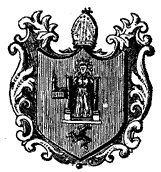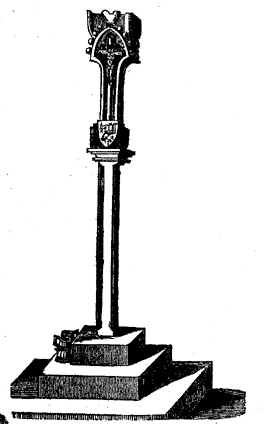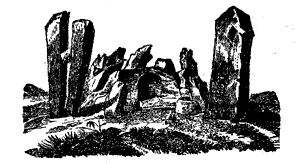
[From Cannell's Guide, 1843]
To the northern part of the Island; the first part of the road to which, viz. to St. John's, our tourist is well acquainted with ; at that place he will turn to the right, and proceed through a deep and solitary glen, and then ascend a steep tiresome bill, of more than a mile in length, called Craig Willie's Hill, after which the country possesses no attraction for several miles; but as the beautiful village of
is approached the scenery is greatly improved, and several pleasant cottages meet the view. At the entrance to the village is a small Court-house, in which the Northern Deemster occasionally transacts business, nearly adjoining which is the Crown and Mitre, a comfortable hotel, kept by Mr. Stacey Gee, an agriculturist to a great extent; the tourist will experience from the fascinating hostess, and every one under her control, the most polite and attentive consideration. Kirk Michael is a place, independent of the beautiful scenery around it, interesting, as having been the home scene of Bishop Wilson's active benevolence for wore than half a century.
The Church is nearly in the centre of the village, it is a newly erected building, being one of those raised principally,from funds obtained for the purpose in England, by the late, Bishop Ward and the Rev, Hugh Stowell. There are no records to prove when the old church was built, but the register begins in 1611. The first thing which attracts attention in the Church-yard is the plain tomb to the memory of Bishop Wilson, for a description of which see page 18.
In and near the church-yard are various stones and monumental relies, on which are chiselled numerous devices of horses, riders, dogs, and stags, with runic characters, which being differently translated by various antiquarians, we decline inserting, but substitute instead the following lines of Southey..
"Thus o'er some antique ruin, time defac'd,
The sons of science oft delight to stray,
To trace the inscription on the desert waste,
And pierce time's dark veil by its lucid ray.But vain the labours of th'enquiring sage,
If thence the mind no moral truth sublimes
Nor learns from heroes of a distant age,
To love their virtues, and to shun their crimes."
Bishops Hildesley, Mason, and Crigan, were also buried in this church-yard.
The vicarage house is pleasantly situated at the end of the village, the present incumbent is the Rev. J. Brown, the Episcopal Registrar.
About one mile from Kirk Michael is the Episcopal palace, or
The arms of the Bishoprick are, on three ascents, the Virgin Mary. her arms extended between, two pillars ; - on the dexter, a church ; in base the ancient arms of Mann.

The Bishop's Palace is a very ancient residence, being mentioned in history so early as the thirteenth century. The demesne is extensive, being about six hundred acres. The edifice is surrounded with venerable trees, planted by Bishop Wilson. The gardens are enclosed with lofty walls; richly clothed with the choicest fruit trees, in their most luxuriant state ; from one part of the promises there is a picturesque view of great extent and beauty. The mansion has been enlarged and modernized by different diocesans, particularly by Bishop Murray.
In the grounds are two posts, erected in 1760, by the then Bishop (Hildesley) to commemorate a victory obtained by Captain Elliot, over Admiral Thurot, off the coast ; the contest having been witnessed by the Bishop, he caused those stones to be erected to commemorate the glorious achievement. Capt. Elliot, in a ship of 32 guns, and 200 men, captured the French Admiral's ship of 50 guns and 600 men, and the Admiral was killed in the action. Several other. ships were taken, and carried triumphantly into Ramsey Bay. Two prints of this celebrated action were drawn and engraved, one dedicated to Capt. Elliot, the other to the merchants of Liverpool.
About a mile from Bishop's Court is
which is one of the most populous villages in the Island. A new church has also been recently erected in this parish, out of the funds collected for the pur. pose in the parent country; it is capable of containing seven hundred sittings ; the present incumbent is the worthy and pious Thomas Howard.
The venerable Hugh Stowell, whose remains are deposited by the side of his amiable and beloved wife in Lonan church-yard, was for many years the highly esteemed rector of this parish ;- a man who, when living, was "full of the Holy Ghost and of Faith," and who by the eloquence of his preaching and the goodness of his cause, raised upwards of £4000 in England, in the course of the summer, 1829. Several of his children had been previously consigned to the bosom of their creator in this church yard. Of him the Island poetess, Miss Nelson, says:-
- One by one,
He laid them in the churchyard. The gay band
Of young rejoicing beings they did pass
Briefly and uncomplainingly away,
Unto an early grave amid the plains.
Yea, those young spirits in their purity
Flash'd forth such coruscations ere their close,
As made hearts dream of years of blessedness.
But the Invisible had even then raised
Death's cold extinguisher, and they went out
In their bright spring of glory. Human hopes
And flowers have a brief lifetime:- and the power
That withers violets had breath'd on them,
And they were laid in their unshadow'd youth
Beside their own dear moss-clad sanctuary.
The pious man-that old bereaved gray man,,
Liv'd on in thankfulness amid his flock.
The old church moulder'd, and the wintry winds
In warring o'er it shook its feeble strength. .
A new fane rose. Proudly it tower'd on high.
For a new generation ; proudly smil'd
Above the fallen. The old man died then.
His son, the celebrated Hugh Stowell, of Salford, near Manchester, is a pillar of the church in these needful times. it is near this village where the heads, horns, and skeletons of the gigantic antediluvian elks have been found as mentioned in page 45.
About two miles north of Ballaugh is the parish of Jurby; the church stands on very high ground from which there is a peculiarly fine view of the three kingdoms. Jurby point, which will he seen on the map, is about a quarter of a mile from the church. Immense trunks of oak and fir have been dug up in this parish, and hazle nuts have been found in good preservation which afford matter of surprise and astonishment.
By continuing this road the tourist will arrive at
which is the most northern parish in the Island, and but a short distance from the Point of Ayre,~
Near the road is a high mount surrounded with stones, called Crone ye bollei, a sepulchral tumulus, where
-"In his narrow house
Some warrior sleeps below : his gallant deeds
Haply at many a solemn festival
The bard has harped; but perlsh'd is the song
Of praise, as, o'er these bleak and barren downs
The wind that passes, and is heard no more."
In the church yard is a stone without any engraving ; on seeing which a gentleman wrote extempore the following stanzas
Here. lies, whom no superb inscriptions grace,
No splendid pile, no mausoleum near,
To speak these ashes born of noble race:
Th' -unletter'd stone shews humble nature here.Perhaps thou wert some faithful honest soul,
Though poverty and pain bad sorely press'd
Perhaps no sordid views could e'er controul,
Or keep thy little from a friend distress'd.Perhaps thou wert some genius unreveal'd,
Some Newton, or some favourite of the muse:
Alas ! that cruel penury conceal'd,
And meanly conquer'd, nature's noble views.'Perhaps thou wert an unknown wanderer here,
Whom better lot had marked in earlier years
But adverse fortune gave a stroke severe,
And left thee to depart in beggar's tears.Too oft 'tis merit's fate to be distressd !
But still thou would'st not unlamented die;
The tender heart would pity as it pased,
The feeling muse would turn and heave a sigh!
About a mile from Bride toward Ramsey is
the beautiful residence of the venerable Archdeacon Hall; it is a rectory in the gift of the Crown. There is an ancient fort behind Mr. Christian's, at Ballachurry which is esteemed a great curiosity. There is also an ancient cross or monument in the church yard with runic characters which Mr. Beaufort has thus decyphered and translated :
"Sona ulf sul Svandt! raisti crus dono Aftlrarin finiue Cunna sina."The son of Ulf of the Swedti (or Swedes) erected this Cross to the warrior Afterarin the son of Cunna."
As we branched off at Ballaugh, we will again resume our route from that village, and on our way to Ramsey, pass through the village of
in which is a beautiful Glen. The soil is fertile, and the produce abundant. Proceeding onward, we pass by the church of
which is another religious edifice erected out of funds raised in England for building Churches. From Sulby bridge to Ramsey, the base of the mountains is prettily wooded, and adorned with many pleasant country residences, amongst which is Milntown, the elegant seat of Deemster Christian.
is a pleasantly-situated town ; the streets are clean and well paved, and the houses are respectable. There is a good inn, kept by Mr. Josiah Heelis, where every comfortable accommodation may be had. The northern Deemster holds his court in this town, for whose convenience a very neat Court-house has been built. The town and harbour have been greatly improved lately, and improvement is still progressing. The bay is spacious, and the anchorage good. The harbour will admit vessels of 100 tons. Much corn and agricultural produce are exported from this town. A chapel, dedicated to St. Paul, is situated in the Market place; it was erected in 1819, by subscription, with a grant of £300 from the Incorporated Society for the enlargement of Churches.
About a mile from Ramsey on the Douglas road, on a knoll at the foot of the mountain range, embosomed in trees of dark foliage, is one of those ancient remnants of rustic piety which are now fast crumbling to decay, and giving place to others of more substantial construction and larger dimensions.
"Fall'n fabrick ! pondering o'er thy time trac'd walls,
Thy mould'rlng, mighty, melancholy state;
Each object to the musing mind recalls
The sad vicissitudes of varying fate."
A little further on, at the foot of Ballure bridge, is a pleasant, agreeable walk along the umbrageous glen of Claughbane, the residence of Wm. Christian, Esq.; After ascending the hill, by leaving the lofty mountain of South Barule on the right hand and taking the shore road, the tourist will pass the villas of Folieu, Bell Vue, and Lewaigue, and come to a stone of considerable antiquity six feet high three wide. and five inches thick, with five raised ball's on it, supposed to be Danish. Passing onward he will arrive at
In the church-yard is a beautiful pillar, of which the annexed plate is a representation.

Maughold is in a hollow, within the midst of an extensive cemetery; a dreary but romantic spot. The church is 72 feet long, and only 17 broad. The font is very large, evidently made for the total immersion of the infant.
The parish and headland derive their appellation from one of the earliest events in Manx history on record; viz. the landing of St. Maughold on this coast, cast ashore in a leathern boat, his feet and hands in manacles. This headland and the Point of Ayre enclose Ramsey bay. Beneath the head, under some moss clad rocks, is a deep, spring, formerly much celebrated for its supposed medicinal virtues.
At Ballaglas, about three miles further, and nearly a mile seaward from the road, there is a very pretty waterfall, beautifully wooded, which, if the party have leisure, will he well worth visiting; and on the top of the cultivated rising ground, nearly south-west, there is a Druidical circle, to which, till very lately, some ruins called Castle-ri-Orry, Castle of King Orry, were attached.
About seven miles from Ramsey the tourist will arrive at the small village of
in the parish of Lonan, near which Snafield rears its venerable head.
Magnificent is Snafield,-from its height
The eye can wander o'er a vast extent o
Of vale and mountain, tinted sunny bright,
In which all glorious hues are richly blent.'
It is somewhat difficult to ascend, but when the brow be attained, a bursting prospect spreads around upon the astonished eye, which rolls over the ocean, embracing numerous objects of interest, unrivalled in Great Britain.
Laxey Glen is deserving of notice for the romantic beauty of its scenery; a short way up it is a paper mill, and considerably beyond that the lead mines, described in page 49.
At some distance on the road to Douglas, are twelve stones, placed in an oval form ; just without the oval are two other. six feet high, one of which is cloven from top to bottom; the whole are erected on. a mound of earth four feet high ; the annexed cut will give the visitor some idea of it.

Between this spot and Onchan there is nothing worthy of notice, and that parish is described in folio 89.
Having conducted the tourist round the Island, and pointed out every thing worthy inspection, we now terminate our labour, and hope that the little work will prove a source of rational amusement, and, interesting information to the visitor.
|
|
||
|
|
||
|
Any comments, errors or omissions
gratefully received The
Editor |
||